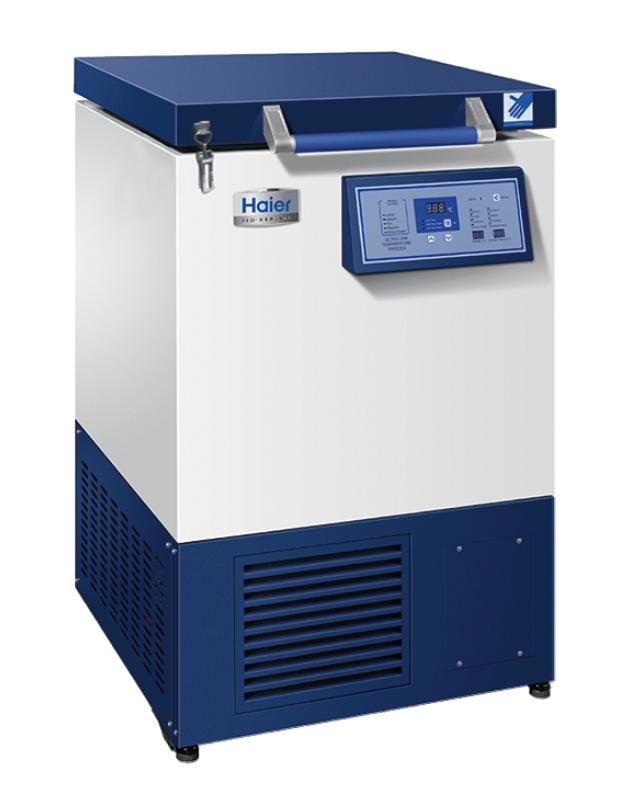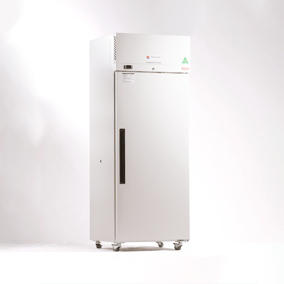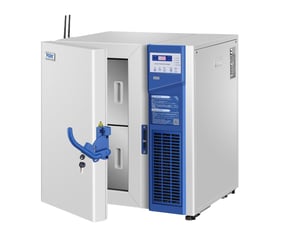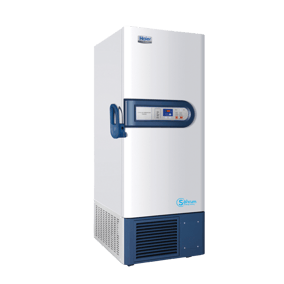-80°C Ultra Low Temp Chest Freezer DW-86W
Overview
Haier's Ultra-Low Freezers are equipped with a unique insulated inner door configuration consisting of four independent storage compartments that effectively minimise frost formation inside the chamber. Each door is sealed to prevent cold temperature loss during opening. These doors are engineered to provide individual access to the storage areas, ensuring maximum protection of the samples stored within. Haier's ULT Freezers boast a microprocessor-controlled system that allows for a range of temperature control between -40°C to -80°C, with increments of 1°C. The specialised control system ensures the smooth operation of the cascade refrigeration system, providing a well-balanced performance. The freezer also has multiple built-in system protection features such as user-settable protection codes, a delay to start, a voltage compensation system, and protection against high voltages. The Ultra-Low Freezers are equipped with malfunction alarms to alert users of high and low temperatures, power outages, sensor errors, high and low voltage, clean-filter, and high ambient temperatures. Additionally, these freezers are renowned for their world-leading energy efficiency, consuming only 11.5Kwh/day. The innovative refrigeration design reduces operational noise while maintaining reliable performance, allowing the cabinet temperature to reach -80°C with temperature uniformity within +/-4°C. The freezer features a large LED display that indicates cabinet temperature, set temperature, ambient temperature, and input voltage. The temperature alarms can be set to high and low temperatures, and automatic clean-filter alarms and sensor error alerts can be adjusted accordingly. The storage shelf height is also adjustable, and the freezer can be connected to network and remote alarm systems. The specialised refrigeration system employs whisper-quiet fans and compressors, and a USB port allows for temperature data downloading. Safety padlocks can also be used on the outer door, and the freezer is UL and CE certified for safety and quality assurance.Specifications
- Dimensions
-
DW-86W100J External WxDxH (mm) 769x825x1120 Internal WxDxH (mm) 470x450x480 Packing WxDxH (mm) 845x855x1250 - Technical Specifications
-
DW-86W100J Technical Data Cabinet Type Chest Climate Class N Cooling Type Direct Cooling Defrost Mode Manual Refrigerant HC Sound Level ((dB(A)) 49 Performance Cooling performance (°C) -86 Temperature Range (°C) -40~-86 Control Controller Microprocessor Display LED Electrical Data Power Supply (V/Hz) 220~240/50 Power (W) 550 Electrical Current (A) 4 Capacity (L/Cu.Ft) 100/3.5 Loading Quantities Container Load (20'/40'/40'H) 12/24/48 Net/Gross Weight (kg) (approx) 138/160 - Features
-
DW-86W100J Caster ✔ Foot ✔ Porthole ✔/1 Shelves/Inner doors -/1 USB Interface ✔ Remote Alarm ✔ 5V Power Supply Port X Temperature Recorder Optional Rs232/485 Interface Optional CO2 Backup System Optional LN2 Backup System Optional - Safety
-
DW-86W100J High/Low Temperature ✔ Hot Condenser ✔ Power Failure ✔ High/Low Voltage X Sensor Error ✔ Low Battery ✔ High Ambient Temperature ✔ Door Ajar ✔
Downloads
Support & FAQs
At Thermoline, we strive to supply helpful customer support to ensure that you get the most out of our products. We are committed to providing whatever support our customers need, wherever they are in the world. If you can't find your solution in the below FAQs or Knowledge Base, please contact our friendly support team.
- How often should you defrost a lab freezer?
The frequency of defrosting a lab freezer depends on the model and the usage pattern. However, it is generally recommended to defrost a lab freezer at least once or twice a year to maintain its optimal performance.
A buildup of ice in the freezer can reduce its efficiency and increase the risk of freezer burn, damaging the quality of the samples stored inside. It can also increase the risk of mechanical failure, leading to costly repairs or even loss of samples.
Following the manufacturer's instructions for defrosting the freezer is important, as the process may vary depending on the model. Generally, defrosting should be done when the freezer is relatively empty, with the samples stored elsewhere temporarily. The freezer should be turned off and allowed to thaw completely before cleaning and restarting.
In addition to regular defrosting, keeping the freezer clean and well-maintained is vital to ensure its longevity and reliability.
- What different types of laboratory freezer are available?
There are several types of laboratory freezers available, including:
-
Upright freezers: These freezers have a vertical orientation and are available in a range of sizes, from under benchtop models to large capacity units that can store hundreds of samples. Upright freezers typically have several shelves, drawers or compartments for easy organisation of samples.
-
Chest freezers: Chest freezers have a horizontal orientation and are often used for storing large or bulky items. They are more energy efficient than upright freezers and can provide longer holdover times during power outages.
- Biomedical Chest Freezers: These -60°C chest freezers are suitable for storing a wide variety of biological products including viruses, bacteria, blood cells, skin and bone as well as ocean-going supplies and electronic devices.
-
Ultra-low temperature freezers: These freezers provide even lower temperatures, down to -80°C. They are often used for long-term storage of biological specimens, vaccines, and other critical materials.
-
- What is an ultra low freezer?
- These are freezers designed specifically for laboratories to preserve biological samples. These provide a stable temperature from -40C right down to -80C
- How does an ultra low freezer work?
Ultra Low Freezers make use of cascade refrigeration. A cascade refrigeration system is a type of refrigeration system that uses two or more refrigeration cycles operating at different temperature levels to achieve extremely low temperatures. It is commonly used when standard refrigeration systems cannot achieve the desired temperature range.
In a cascade refrigeration system, two or more refrigeration cycles are arranged in series, with the evaporator of one cycle serving as the condenser of the next cycle. The cycles are typically designed to operate at different temperature levels, with the coldest cycle being used to achieve the desired low temperature.
- What is the temperature range for ultra low freezer?
The temperature range for ultra-low freezers is typically between -80°C and -40°C. These freezers are designed to maintain extremely low temperatures for long-term biological and other temperature-sensitive materials storage. They are commonly used in research and clinical laboratories, biobanks, and other facilities where the storage of valuable samples and specimens is required.
Most ULTs create a consistent environment where the freezer's internal temperature remains between -70°C and -80°C.
- What are the benefits of a chest freezer over upright?
There are several benefits of owning a chest freezer over an upright:
-
More Storage Space: A chest freezer provides extra storage space, which is particularly useful if you have a large products or samples.
-
Energy Savings: Chest freezers are generally more energy-efficient than upright freezers, as they have less air space to cool and maintain their temperature more easily. This can result in lower energy bills over time.
-
Emergency Preparedness: In the event of a power outage, a chest freezer will keep samples frozen for a longer period of time, giving you more time to find an alternative solution. This can be particularly important during natural disasters or other emergencies.
-









